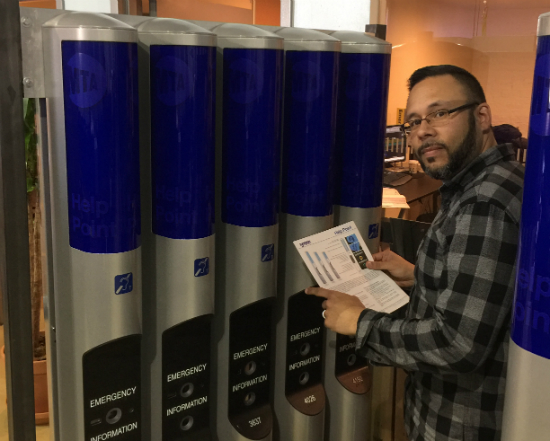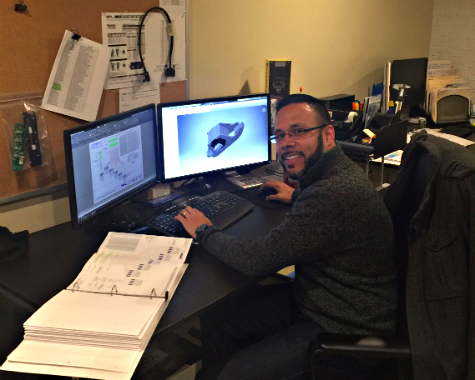
Sometimes where you start your career is not where you end up. Chris Ramirez, Senior Computer Aided Drafting Designer, or CAD Designer, of Boyce Technologies found that a 12-year career in architecture left him feeling a bit bored. Chris was searching for something that would renew his drive and creativity. So he walked away from architecture and used his expertise in AutoCAD to work for Siemens, where he did electric, mechanical, and industrial design. His expertise then led him to become the first employee ever hired at Boyce Technologies, which in turn provided him the opportunity to become involved in the development of the Help Point Unit from its earliest stages.
Chris, who is also a lecturing professor at the Pratt Institute (Manhattan Campus) and the New York Institute of Technology (NYIT), joined Boyce Technologies after leaving Siemens. A mutual acquaintance contacted Charles Boyce and informed him that Chris’ services were on the market. Charles had worked with Chris on previous projects while Charles was at his former company and knew Chris would be an asset to the company he was just starting. Charles remembers, “I had no idea if Chris would want to take a gamble on a new venture. I had no office, no real staff, and no contracts. But I had lots of ideas and plenty of drive. I called Chris and asked him if he wanted to take a chance. Chris jumped in, and the rest is history.”
Chris has been with the company, as the first hire, for close to seven years. “I’ve been through the ups and downs, all the crazy ideas and projects that we have done. And when the phone call came in from New York City Transit regarding the Help Point, that was what made everything steamroll,” says Ramirez, “I was sitting across from him at the kitchen table because when he started the company, we were working out of his apartment. I hear all of this, he hangs up the phone, and I could see the light bulbs going off over both of our heads. I told Charles ‘You got it!’” Boyce’s Help Point Unit was born at that kitchen table. “It’s a magnificent feeling I was able to be involved from the start, and I was eager to say I was there at the conception and then actually see it get fabricated, get built, get installed and placed in the New York City Transit system.”
When asked what goes through his mind when he sees the Help Point Units in the New York City Transit System as a member of the development team Chris says “It’s a great feeling! Anybody who is in an industry as an inventor, an entrepreneur, someone who creates things for others, knows that feeling. You know that I was there when this all started many years ago. Now I actually see it out there in the city, in the train stations. I’m looking at it and touching it. I have friends and family who reach out to me now and then and tell me ‘hey, I was over at Times Square and looked over and saw your Help Point. That is so cool!’ It’s a great and wonderful feeling. Especially with my two daughters, they had to go on field trips with their school, and they are at the train station waiting with the class to go somewhere. All of a sudden they look over and they see a Help Point Unit. They get to brag and say ‘my Daddy works for the company, my Daddy made that.’ It’s a nice warm and fuzzy feeling.”
With all the innovations produced at Boyce Technologies, Chris still feels the Help Point Unit is best of them all. “There was an idea of what the Help Point needed to do. The form and the function. But Charles looking at it said ‘No, this can be better, we can do more.’ The innovation, the study, the design and the work that went into it, and continues to go into it, is still amazing. Charles is always trying to find a way to make it a little bit better than it was before.”
“The Help Point,” Ramirez continues, “has transitioned and evolved, and this trickles down to many of the other products and things we do here at Boyce Technologies. The Help Point Unit has been like a nurturing parent. The creation and start of the Help Point Unit have led to many great and successful products that we make here at the company. And it never stops. We are always working and continuing to go above and beyond to make it better, make it more innovative, completely streamlined, and take to the next level.”

As part of this continued innovation, Boyce Technologies is now implementing the use of Auto Desk Inventor, 3D Modeling software. Chris, Charles, and their colleagues on the development team use Auto Desk Inventor to conceptualize and build working 3D models of components they can then make physically at the company. Auto Desk Inventor simulates, in a 3D environment, the products and examines how the product interacts together and can check for flaws or boundaries that would hinder development. This can help reduce man hours and machine time.
Considering that Chris Ramirez was employee #1, how does he feel when he sees accolades such as the “Inc. 500” and Crain’s “Best of New York” designations? “It’s an overwhelming feeling knowing that a company that started off as one person, then along comes the first hire where all we had was two computers sitting across from each other at a kitchen table. Starting off as a two-man operation – here we have Charles Boyce who is this incredible designer and inventor with all these great ideas, and then I’m sitting across from him and I’m taking those ideas and putting them down in a computer and putting them in a way that is legible where we can now share it with the world. Then I look over my shoulder now, and I see this large fabrication facility, an assembly facility, over 70 employees now, and our name is out there. Everyone knows who Boyce Technologies is! It’s a great feeling that something that was a concept, something that was an idea, the hard work that Charles put into this, sweat and tears, and he just didn’t give up. Then I come along, and I’m taking a chance on this startup company, but I knew Charles, and I knew his reputation. I felt confident in saying ‘I’m going to go in, and give it all I got and I know this is going to go somewhere.’ It is something I do not regret doing. Going on seven years later I still enjoy it every single day.”
Advice on becoming a CAD Designer
What advice would Chris give others who are looking to become a CAD Designer, or get a career working in engineering or manufacturing? Chris states, “Regardless of how difficult and intimidating you might think it is, and how you may feel that you may not be suited for it, the only way to know is to just actually do it. Just get involved, give it a try. My educational background was architecture. I was studying about buildings, construction, and design. At no point did I ever see myself transitioning from that to mechanical design or industrial design. But I wasn’t afraid. I was given an opportunity, and I said I have nothing to lose. What I have here is more to gain.”
[gravityform id=”3″ title=”true” description=”true”]
